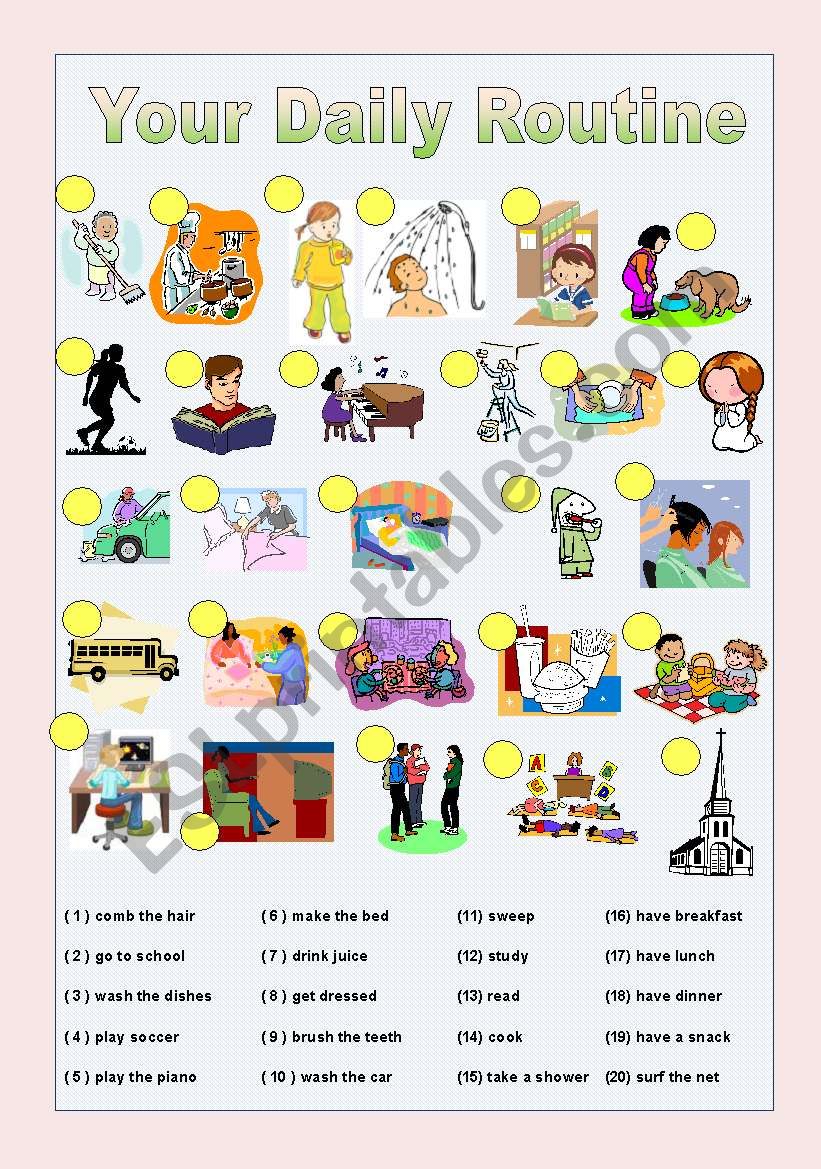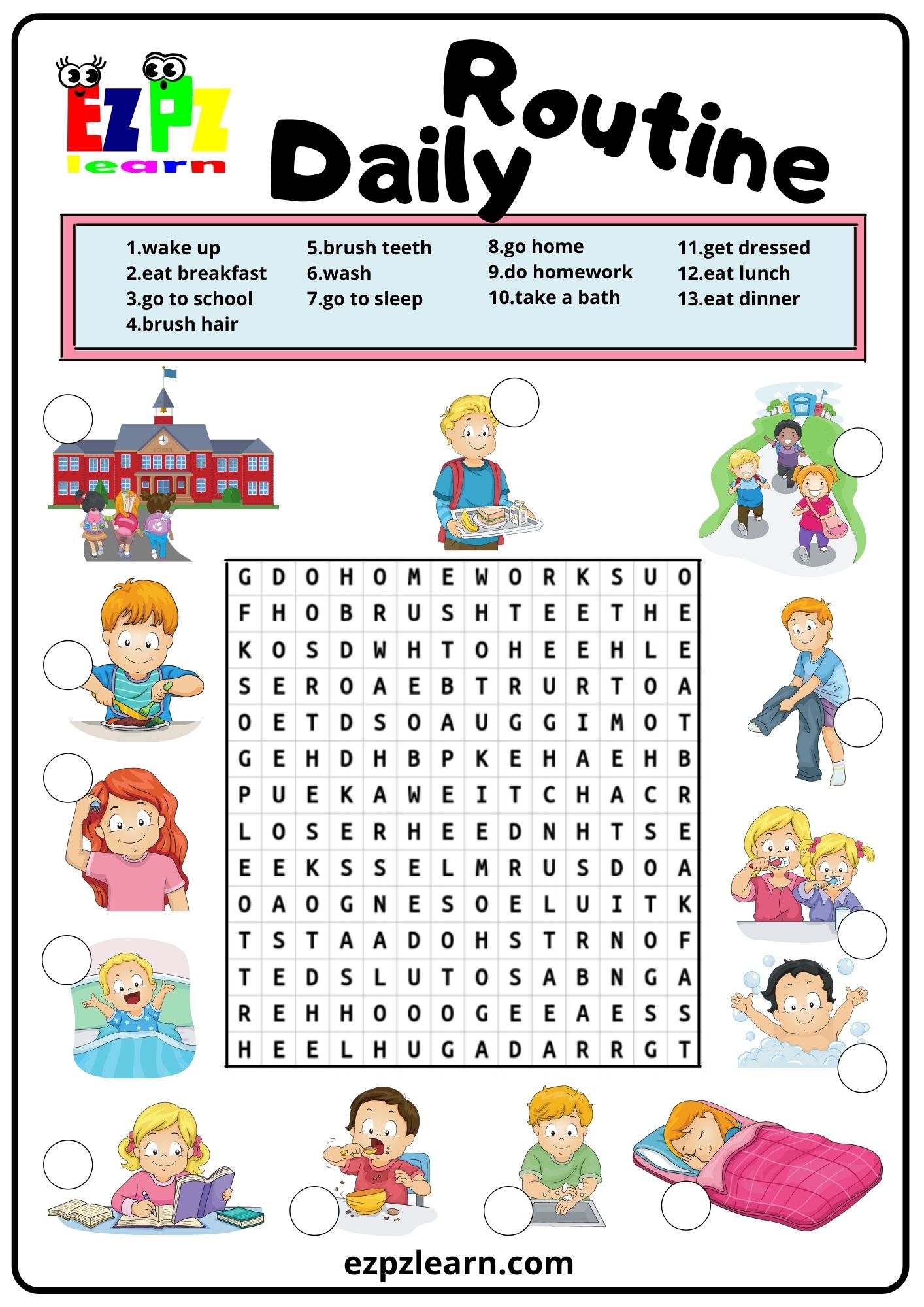
Mastering Language with Everyday Vocabulary Worksheets: A Comprehensive Guide
In the vast landscape of language acquisition, vocabulary stands as the bedrock upon which all communication is built. While grammar provides the structure and pronunciation gives life to words, it is vocabulary that conveys meaning. However, not all vocabulary is created equal. Academic jargon, specialized terminology, or historical lexicons, while important in their specific contexts, often fall short when it comes to navigating the practicalities of daily life. This is where Everyday vocabulary worksheets emerge as an indispensable tool, offering a structured, accessible, and highly effective pathway to mastering the words and phrases essential for real-world interactions.
This comprehensive guide will delve into the profound importance of everyday vocabulary, the unique benefits offered by worksheets, how to design and utilize them effectively, and how they integrate into a holistic language learning strategy.

The Undeniable Importance of Everyday Vocabulary

Everyday vocabulary refers to the common words and phrases used in routine conversations, common situations, and general understanding of the world around us. It encompasses everything from ordering coffee and asking for directions to discussing current events, expressing emotions, or understanding a simple news report. Without a solid grasp of this vocabulary, even individuals with advanced grammatical knowledge can find themselves lost in translation.

Why is everyday vocabulary so crucial?

- Immediate Practicality: It allows for immediate application in real-life scenarios. You can buy groceries, ask for help, make small talk, or understand announcements without needing a dictionary every five minutes.
- Confidence Building: Being able to understand and use common words boosts a learner’s confidence, encouraging them to engage more frequently and fearlessly in conversations.
- Foundation for Deeper Learning: A strong everyday vocabulary serves as a stable base for acquiring more complex or specialized terminology. Once you can comfortably discuss daily routines, you can then move on to discussing politics, science, or literature.
- Cultural Integration: Everyday language often carries cultural nuances. Understanding common idioms, slang, or conversational fillers helps learners not just speak the language but also understand the culture behind it.
- Reduced Anxiety: The fear of not understanding or being misunderstood is a major barrier for many language learners. A robust everyday vocabulary significantly reduces this anxiety, making the learning process more enjoyable and sustainable.


Why Worksheets Are Your Best Friend in Vocabulary Acquisition

While immersion and direct conversation are invaluable, they can be overwhelming without prior preparation. This is where Everyday vocabulary worksheets provide a structured and manageable approach to learning. They offer a unique blend of benefits that cater to various learning styles:
- Structured Practice: Worksheets break down the vastness of vocabulary into manageable, thematic chunks. This systematic approach prevents learners from feeling overwhelmed and allows for focused learning on specific areas (e.g., "Kitchen Utensils," "Public Transport," "Expressing Opinions").
- Active Engagement: Unlike passive reading or listening, worksheets demand active participation. Learners must recall, write, match, or complete sentences, which strengthens memory retention through active processing rather than mere recognition.
- Variety of Exercises: Good worksheets incorporate diverse exercise types – matching, fill-in-the-blanks, crosswords, word searches, sentence construction, true/false, multiple choice, and even short writing prompts. This variety keeps the learning engaging and caters to different cognitive preferences.
- Self-Paced Learning: Learners can work through worksheets at their own pace, repeating sections as needed without pressure. This autonomy is particularly beneficial for self-learners or those with busy schedules.
- Tangible Progress: Completing a worksheet provides a clear sense of accomplishment. Learners can visually track their progress, reinforcing motivation and showing them how much they’ve learned.
- Reinforcement and Review: Worksheets are excellent for reinforcing recently learned words and for periodic review of older vocabulary, helping to combat the "forgetting curve."


Crafting Effective Everyday Vocabulary Worksheets
Whether you are a teacher designing materials or a self-learner creating personalized practice, understanding the principles behind effective Everyday vocabulary worksheets is key.
-
Theme-Based Organization: This is paramount for everyday vocabulary. Group words by context where they are naturally used. Examples include:
- At Home: (e.g., couch, refrigerator, chores, landlord, rent)
- In the City: (e.g., traffic jam, subway, pedestrian, crosswalk, skyscraper)
- Food & Dining: (e.g., menu, waiter, bill, tip, appetizer, main course)
- Health & Wellness: (e.g., symptoms, prescription, pharmacy, appointment, dizzy)
- Work & Office: (e.g., meeting, deadline, colleague, memo, presentation)
- Emotions & Feelings: (e.g., frustrated, delighted, anxious, relieved, puzzled)
- Travel & Tourism: (e.g., passport, boarding pass, luggage, customs, itinerary)
- Shopping & Commerce: (e.g., discount, cashier, receipt, refund, try on)
-
Contextual Learning: Present words not in isolation but within sentences, short dialogues, or paragraphs. This helps learners understand nuance, collocation (words that often go together), and appropriate usage. For example, instead of just "run," include "I need to run some errands" or "The bus runs every 15 minutes."
-
Variety of Exercise Types:
- Matching: Word to definition, word to picture, word to synonym/antonym.
- Fill-in-the-Blanks: Provide sentences with missing vocabulary words.
- Sentence Creation: Ask learners to write their own sentences using the new words.
- Multiple Choice: Offer several options for a word’s meaning or usage.
- Crosswords/Word Searches: Fun ways to recognize and recall words.
- Categorization: Ask learners to group words into logical categories.
- Short Answer Questions: Prompt learners to use the vocabulary to answer questions related to the theme.
-
Visual Aids: Incorporate images, diagrams, or illustrations. Visuals make learning more engaging and help learners associate words directly with objects or concepts, especially beneficial for concrete nouns and verbs.
-
Clear Instructions and Answer Keys: Ensure instructions are simple and unambiguous. Provide a clear answer key for self-correction, which is vital for independent learning and immediate feedback.
-
Progression and Scaffolding: Start with simpler tasks and gradually introduce more complex ones within the same theme. For example, begin with matching, then move to fill-in-the-blanks, and finally to sentence creation or a short paragraph.
-
Gamification Elements: Introduce elements of fun like point systems, challenge levels, or "bonus rounds" to keep motivation high.
Maximizing Learning with Everyday Vocabulary Worksheets
For learners, merely completing the worksheets is not enough. To truly internalize the vocabulary, active strategies are essential:
- Active Engagement, Not Passive Completion: Don’t just fill in answers. Say the words aloud, visualize them, and try to think of personal connections to them.
- Regular and Consistent Practice: Short, frequent sessions (e.g., 15-20 minutes daily) are far more effective than long, infrequent ones. Consistency builds habit and strengthens memory.
- Contextualize Beyond the Worksheet: After completing a worksheet, try to use the new words in your own sentences, speak them in a simulated conversation, or look for them in real-world contexts (e.g., a news article, a sign, a song lyric).
- Pronunciation Practice: As you learn new words from the worksheet, look up their pronunciation using online dictionaries or language apps. Practice saying them correctly.
- Review and Revisit: Don’t just put a completed worksheet away. Periodically review previous worksheets to reinforce learning and move words from your passive vocabulary (words you recognize) to your active vocabulary (words you use).
- Create Your Own Sentences/Scenarios: Take a few words from the worksheet and write a short story or dialogue using them. This forces creative application.
- Combine with Other Learning Tools: Use flashcards (digital or physical) for quick review of words learned from the worksheets. Listen to podcasts or watch videos related to the worksheet’s theme.
Integrating Worksheets into a Holistic Learning Strategy
While incredibly effective, Everyday vocabulary worksheets are most powerful when integrated into a broader language learning ecosystem:
- Reading: After learning vocabulary about "travel," read a travel blog or a tourist guide.
- Listening: Listen to podcasts, watch TV shows, or listen to native speakers talk about everyday topics.
- Speaking: Practice using the new words in conversations with language partners, tutors, or even by talking to yourself.
- Writing: Use the vocabulary in journaling, emails, or short descriptive paragraphs.
- Real-World Application: Actively seek opportunities to use the vocabulary in authentic situations – ordering food, asking for directions, making a purchase. This is the ultimate test and reinforcement.
Overcoming Common Hurdles in Vocabulary Acquisition
Even with the best worksheets, learners can face challenges:
- The Forgetting Curve: Words learned today might be forgotten tomorrow. Solution: Spaced repetition. Review words at increasing intervals (e.g., 1 day, 3 days, 1 week, 1 month).
- Lack of Motivation: Learning can feel like a chore. Solution: Make it fun! Use gamified worksheets, set small achievable goals, or reward yourself.
- Overwhelm: Too many words at once. Solution: Break it down. Focus on 5-10 new words per day, or one theme per week.
- Passive vs. Active Vocabulary: Recognizing a word is one thing; using it spontaneously is another. Solution: Deliberate practice using words in speaking and writing tasks.
- Pronunciation Disconnect: Knowing the word but not how to say it. Solution: Always check pronunciation and practice speaking aloud.
The Future of Everyday Vocabulary Learning
The evolution of technology continues to enhance how we learn. Digital versions of Everyday vocabulary worksheets are becoming more interactive, incorporating audio for pronunciation, instant feedback, and adaptive learning algorithms that tailor content to individual progress. AI-powered platforms can generate personalized worksheets based on a learner’s specific needs and interests, making the process even more efficient and engaging. Virtual reality and augmented reality might soon offer immersive environments where learners can practice everyday vocabulary in simulated real-world scenarios, blurring the lines between practice and actual application.
Conclusion
In the journey of language mastery, Everyday vocabulary worksheets are far more than just paper and pen exercises; they are meticulously crafted tools designed to equip learners with the practical linguistic skills necessary for navigating daily life. By providing structure, encouraging active engagement, and offering diverse practice opportunities, they transform the daunting task of vocabulary acquisition into an achievable and enjoyable endeavor.
Whether you are a beginner taking your first steps or an advanced learner refining your fluency, integrating everyday vocabulary worksheets into your routine will undoubtedly accelerate your progress, build your confidence, and unlock the doors to genuine, spontaneous communication in the target language. Embrace them, utilize them wisely, and watch as your ability to connect with the world around you blossoms.
